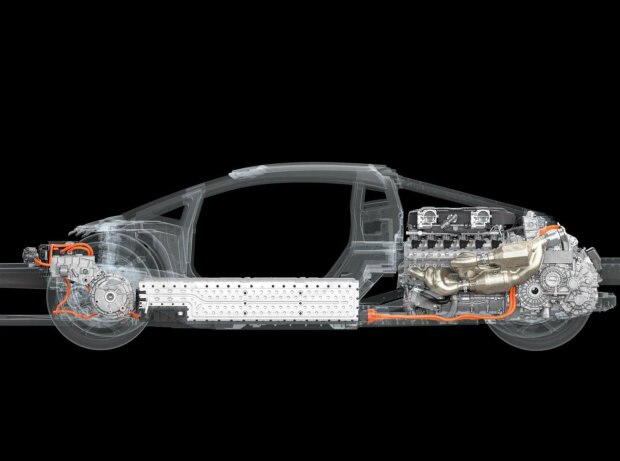The PHEV all-wheel drive consists of a 6.5-liter combustion engine with 825 hp and three electric motors: All information and details on the structure of the drive can be found here
(Motorsport-Total.com/Motor1) – The Lamborghini Aventador legacy is ready: so far we have shown you images of camouflaged prototypes caught during development testing, but now we have the first official information about the new Lamborghini supercar, which Sant’Agata Bolognese has initially given the project name LB744.
The petrol engine is a naturally aspirated 6.5-litre V12 with an output of 825 hp at 9,250 rpm and a torque of 725 Nm at 6,750 rpm, plus three electric motors for a total system output of 1,015 hp All-wheel drive is standard. Featuring two electric motors on the front axle (one on each wheel) and one electric motor on the rear axle, coupled with a new 8-speed dual-clutch gearbox behind the V12 engine that replaces the Aventador’s 7-speed gearbox.
So here we have a plug-in hybrid supercar that, for the first time, electrifies the tradition of naturally aspirated V12 engines from all Lamborghini’s predecessors. The lithium-ion battery with a capacity of 3.8 kWh can be recharged in 30 minutes with AC power of up to 7 kW, or in 6 minutes using regenerative braking and using the V12 engine while driving.
But that’s not all: the new Lambo is also built on a new platform that creates a technical link to its Lamborghini Miura and Lamborghini Countach ancestors. As with the Miura, the gearbox is also arranged transversely behind the engine. So the gear box is no longer located in the central tunnel that separates the passengers in the passenger compartment.
A technical choice introduced on the Countach and maintained on the later Diablo, Murciélago and Aventador models. This newly gained space in the center tunnel now houses the lithium-ion battery.
The model with the project name LB744 does not have a supercapacitor like the Lamborghini Sian, but has a “real” battery, making it a “PHEV” (i.e. a plug-in hybrid vehicle). Or, according to Lamborghini, to an “HPEV”. A new acronym that the manufacturer lets stand for “High Performance Electrified Vehicle”.
Like the Aventador, Murciélago and Diablo, the new V12 super sports car has all-wheel drive. This time, however, with two electric motors on the front wheels – which also influence the handling by controlling the torque distribution with torque vectoring. The electric front axle is combined with a combustion engine rear wheel drive, which is also supported by a third electric motor with 150 hp.
The torque of the petrol engine is (as already mentioned) 725 Nm, 150 Nm is contributed by the rear electric motor and 350 Nm each comes from the two front electric motors. They are oil-cooled axial motors with torque vectoring and energy recovery.
You can also drive 100 percent electrically. Only with the front axle. The rear wheels then engage when needed. The rear electric motor is also used to start the V12 petrol engine and acts as a generator, powering the battery and front electric motors. In pure electric mode, it drives the rear wheels directly and thus provides a performance boost.
The rear electric motor is mated to the 8-speed dual-clutch gearbox with special synchromesh, with reverse normally taken over by the two front electric motors, but the rear one being able to step in when more momentum is needed.
The new gearbox was developed by the engineers in Sant’Agata Bolognese. It is an oil bath unit mounted transversely behind the V12 engine and under the rear electric motor. It consists of two waves. One for the even and one for the odd gears that mesh with the same secondary shaft, reducing final weight and keeping overall dimensions compact. This new transmission is also faster and lighter than the Lamborghini Huracán’s 7-speed system.
The combustion engine bears the designation L545 and has a displacement of 6.5 liters. It is lighter and stronger than the previous del Toro brand 12 cylinders. It weighs 218 kg (17 kg less than the unit in the Aventador).
Each cylinder features an intake duct that has been modified compared to the past to increase the volumetric intake coefficient, thus ensuring optimal airflow into the combustion chamber. Combustion is also better controlled thanks to the two-chamber ionization system already used on the Aventador range, with a compression ratio of

